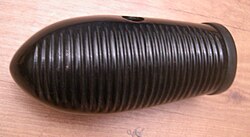Güiro: Difference between revisions
No edit summary |
mNo edit summary |
||
| Line 8: | Line 8: | ||
|classification= idiophone, could be made from wood, gourd, metal, plastic or fiberglass |
|classification= idiophone, could be made from wood, gourd, metal, plastic or fiberglass |
||
|hornbostel_sachs=112.23 |
|hornbostel_sachs=112.23 |
||
|hornbostel_sachs_desc= |
|hornbostel_sachs_desc=Scraped [[idiophone]], vessel |
||
|range=Speed of scrape produces some variation |
|range=Speed of scrape produces some variation |
||
|midi=Notes 73 (short scrape) and 74 (long scrape) (C# and D) |
|midi=Notes 73 (short scrape) and 74 (long scrape) (C# and D) |
||
Revision as of 22:42, 8 July 2012
This article needs additional citations for verification. (December 2009) |
 A modern fibreglass güiro. | |
| Percussion instrument | |
|---|---|
| Other names | Calabazo, guayo, ralladera, rascador |
| Classification | idiophone, could be made from wood, gourd, metal, plastic or fiberglass |
| Hornbostel–Sachs classification | 112.23 (Scraped idiophone, vessel) |
| Playing range | |
| Speed of scrape produces some variation | |
| Related instruments | |
| Güira, reco-reco, slit drum, washboard | |
The güiro (Spanish pronunciation: [ˈɡwiɾo]) is a Latin-American percussion instrument consisting of an open-ended, hollow gourd with parallel notches cut in one side. It is played by rubbing a stick or tines along the notches to produce a ratchet-like sound. The güiro is commonly used in Latin-American music, and plays a key role in the typical rhythm section of important genres like cumbia and salsa. Playing the güiro usually requires both long and short sounds, which are made by scraping both up and down in long or short strokes. The güiro, like the maracas, is usually played by a singer. There's still another type of güiro, commonly found in Brazil (where it's called "reco-reco"), which is made of a cylindrical metal box that encases two or three steel springs. These are stretched over a lid, against which a metal stick is rubbed.
Construction and design
The güiro, which was adapted from a pre-Columbian instrument, is a notched, hollowed-out gourd.[1] The güiro is made by carving parallel fluting on the surface of the shell of the gourd. It is played by holding the güiro in the left hand with the thumb inserted into the back sound hole to keep the instrument in place. With the Brazilian güiro, after frictioning the springs it's possible to make use of the prolonged reverberation, or muffle them with the fingers. In some models, the box also has a bottom hole, allowing the musician to change the internal reverb by covering it or not.
Other meanings
Güiro is also another term for a shekere as well as the ensemble and rhythm used when playing this instrument. In Regla de Ocha, a güiro is a musical performance/ceremony that uses shequeres, hoe blade, and at least one conga to accompany the religious songs of the Orishas.[2]
Gallery
-
Cuban güiro
-
Puerto Rican güiro
-
A guiro for children





